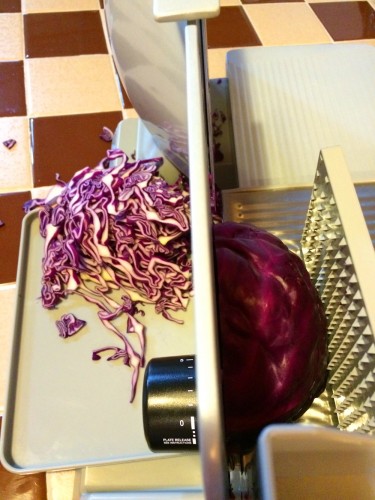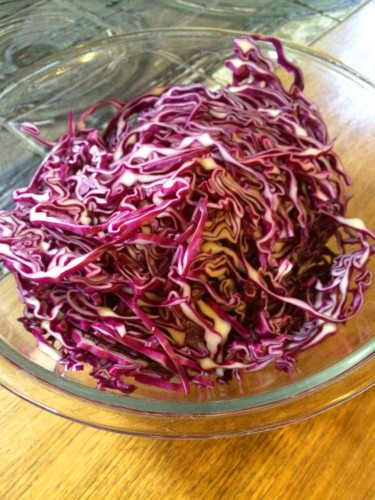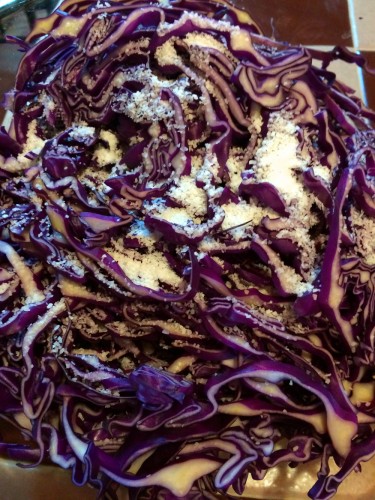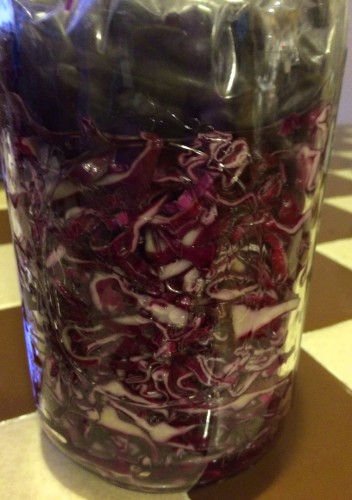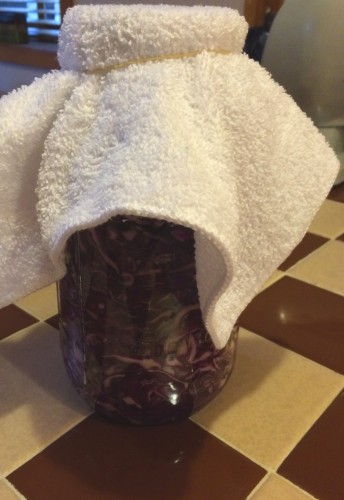Sauerkraut in white plastic bins next to NYC dirty water hot dogs was my only experience with the cabbage condiment until I was well into my 20s. It was a grayish-white, limp, slightly sourish mush to put on top of the dog — dosed with a serious helping of bright yellow mustard to give it some umph. It wasn’t until I had a proper bratwurst dinner with friends from Germany that I finally tasted what fresh sauerkraut could bring to the palate. Crisp, bright, and with a perfect balance of salt and sour. I had to make some of my own.
Sauerkraut is simply made of shredded cabbage fermented in salt. That is it.
I have a slicer — similar to the kind you’d find at a deli, but much smaller — which makes shredding the cabbage easier.
You could also slice by hand or use a mandolin. Reserve one large, unshredded leaf to serve as a cover. Keep the shredded slices relatively uniform in width.
While traditional sauerkraut is made with green cabbage, I much prefer red. Mostly I like red cabbage better because it is prettier to look at. I’ve also read it contains twice the polyphenols of green cabbage and six times the antioxidants, which makes it healthier — all the better.
Once the head of red cabbage is shredded (about 3 pounds), I sprinkle the shreds with 1.5 tablespoons of kosher salt and mix it by hand to cover the cabbage well. The salt will immediately start pulling moisture from the cabbage.
I put the whole shebang into a sterilized 2-quart wide mouthed canning jar 3/4 full. Put the reserved cabbage leaf, trimmed to size, on top of the shredded, salted mix. I half-fill a ziplock bag with rocks — like the kind you’d put in a glass vase — to create a weight. Place the bag of rocks on top of the leaf inside the wide mouth jar and spread the weight evenly to tamp the mixture down.
Put a cloth cover over the top of the wide mouth jar, secure with a rubber band, and let nature take its course for 3 weeks at room temperature. Occasionally check that the fermenting mixture is bubble-free and submerged in its liquid. If there are bubbles, tap the side of the jar and tamp the mixture down to remove any air.
After 3 weeks, put a lid on the jar with the bag of rocks inside. Finish the red sauerkraut in the fridge for 1 week before eating. Take out the weighted bag and re-lid.
It should be good in the fridge for several months. You can make it last longer by water bath canning, but the heat makes the cabbage too mushy for my taste. My recommendation is to make to a batch you can consume within a few months, and if you like it, make a new batch a month before the first batch runs out.
Red cabbage sauerkraut is a perfect complement to foods with a higher fat content — sausages, hot dogs, and cheesy/starchy dishes. It purportedly provides a significant percentage of recommended daily requirements of C, K, and B vitamins in addition to its antioxidant effects. It’s also chock full of probiotics and low in calories (about 20 calories per cup). If you haven’t tried homemade sauerkraut, give it a go. It’s easy to make, healthy, and the taste benefits might make you a convert.
